The oven is suitable for preparing varied and tasty dishes. Roasting is a great alternative to frying that cooks meat, fish, vegetables or baked goods with less or no oil. To ensure that everything is baked evenly and the taste is as rich as possible, ovens use a special technology - convection.
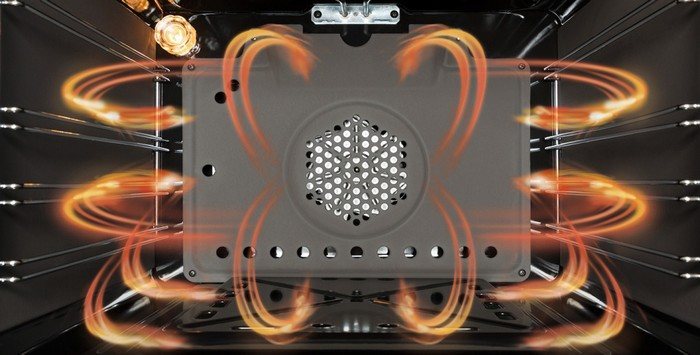
- The concept of "convection"
- Operating principle of convection models
- How to tell if your oven has convection
- Types of convection
- Fan
- Fan with ring heater
- Reinforced convector
- Double convection
- Moist convection
- Differences between wet, enhanced and dry convection
- Convection in various types of ovens
- In a gas oven
- In an electric oven
- In the oven with grill function
- Advantages
- Flaws
- Oven with or without convection: what to choose
- How to choose a convection oven
- Popular brands
- Hephaestus
- Bosch
- Hansa
- Electrolux
- Gorenje
- Ariston
- Gemlux
- Itimat
- What is cooked using convection
- How to use convection
- When to turn it on
- How to turn it on
- How to disable
- Convection cooking
- At low temperatures
- At average temperatures
- At high temperatures
- Subtleties of cooking with convection
- Feedback from users of the mode
The concept of "convection"
The word "convection" is of Latin origin. It is derived from the original convectiō, which is translated into Russian as “transfer”.Convection is a heat exchange in which air flows that heat up and remain cold circulate. Natural convection occurs in any oven - but this physical phenomenon causes food to heat up (and, accordingly, cook) unevenly.
Operating principle of convection models
When we place a dish in the oven and close the lid, a closed space is created inside the oven. It is affected by several heating elements (previously they were only in the lower part of the furnace, but in more modern models they are located evenly and switch when modes change). The air inside the enclosed space heats up and tends upward, while the cold (relatively, because it cannot be cold inside the oven when it is turned on) air remains below. This movement of air masses is called natural convection and, as a physical phenomenon, is present in any oven.
But due to the fact that the air is heated unevenly, it is more difficult to prepare dishes. For example, a large piece of meat can be completely cooked on one side, but remain half-baked on the other.
In order to avoid such a problem, special ovens were developed - they have a special mechanism built into them that creates an even distribution of heated air masses across all levels. Despite the fact that the physical phenomenon of convection is present in all ovens, only those that have the function of forced circulation of hot air are called convection ovens.
How to tell if your oven has convection
To make it easier for customers to choose an oven in a store, special schematic images are placed on it, with the help of which the presence of certain functions is indicated. The most common icons:
- horizontal straight lines – heating elements;
- fan with three blades – convection function;
- horizontal line with teeth – grill.
Ovens offer different modes that combine these features. For example, you can turn on convection and only one heating element, or set it to grill and add a fan for more even cooking. Combined modes allow you to make more delicious dishes; the main thing is to understand which method of cooking in the oven to choose for certain products.
Types of convection
Depending on the type of stove, there are different types of convection. Thanks to the combination of air circulation and additional options (for example, boost or heater), you can cook dishes with varying degrees of doneness at different levels. Expensive ovens have several of them, and the simpler the oven, the fewer convection options it has.
Fan
The simplest type of dry convection, represented by a single fan on the back wall of the oven. When turned on, it accelerates and affects the warming air, which begins to circulate inside the oven.
Fan with ring heater
The operating principle of this type of convection in an oven is similar to the previous one. However, in this case, a special heating element is located around the fan in the form of a ring. It increases the temperature of the air driven by the blades.As a result, it turns out that this type of dry convection is more effective, since it allows the circulating air to warm up evenly faster (heating occurs from several sources at once).

Reinforced convector
In this mode, more powerful fans operate, quickly heating the air and distributing it throughout the entire oven space. This allows you to quickly fry the top layer of the product and create a crispy crust that blocks the evaporation of juices. For example, using this function you can cook fruits in sugar syrup - they quickly caramelize on top and bake inside, maintaining their juiciness. But for pizza, the enhanced mode is not suitable, since the topping on top may burn, and the dough will not have time to cook.
Double convection
Some oven models have double convection: two fans are located one above the other. Each of them ensures air circulation in its “own” zone, so that every corner of the oven heats up evenly. With this function, you don’t have to worry that on the top tier, for example, the pies will bake worse than on the bottom.
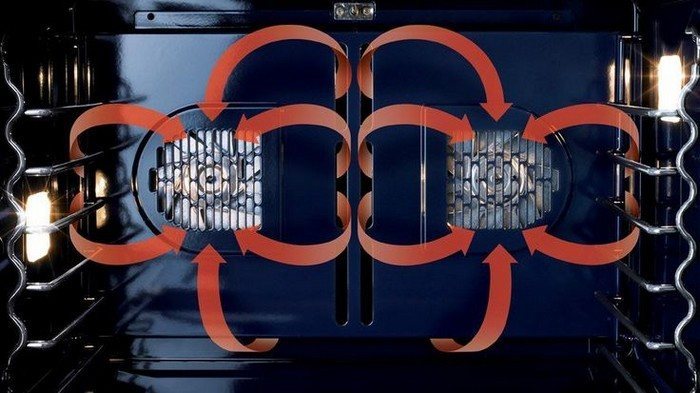
Moist convection
The moist convection mode allows you to steam dishes in the oven. A special reservoir of water is installed along with the fan; when heated, it evaporates and the steam spreads throughout the oven. This function allows you to cook food without frying or oil, which reduces the calorie content of ready-made dishes. Therefore, moist convection is especially appreciated by those who prefer a healthy diet.
Differences between wet, enhanced and dry convection
One way or another, convection is the forced distribution of hot air inside the oven.Dry suggests that circulation occurs due to the movement of the fan, enhanced - that the fans have increased power, and with humid, steam also accelerates along with the air. Thus, dry convection is suitable for organizing uniform heating of the dish, with the help of enhanced convection you can create a crispy crust, and wet convection allows you to steam food.
Convection in various types of ovens
Convection mode can be found in different built-in ovens - both electric and gas. Moreover, even mini ovens (tabletop “boxes” with one or two burners and a small oven) and some microwave ovens are equipped with it.
In a gas oven
A gas stove with a built-in oven allows you to save electricity and does not create unnecessary stress on the wiring. Over the past few years, the convection function has also begun to appear in such models. A special fan accelerates the air inside the stove, but cannot extinguish the fire (it is designed taking into account the characteristics of a gas stove). Also, such models have a special function that will block the gas supply in case of danger.
In an electric oven
Electric ovens are more familiar to most people. Convection in them is organized using fans that circulate air from the heating elements (you can turn on just one or both at once - on both sides). True, this method of cooking will require a lot of energy waste, so it is necessary to install the stove only with stable wiring.
In the oven with grill function
To ensure that the taste of meat in the oven is close to that of cooking over charcoal, a special grill mode is used. For example, this way you can make a delicious barbecue without a barbecue and the need to cook outdoors. In this case, convection can be used in the air fryer mode (the fan heats the air evenly) or turbo grill (fans and heating elements work not only evenly, but also quickly).
Advantages
Convection mode is a convenient function that is needed by those who constantly cook different dishes in the oven. Its advantages:
- The temperature is evenly distributed.
- There is no need to change baking trays with food, as they will be baked well.
- Cooking becomes easier.
- At low heat, you can use this mode to defrost meat and fish.
- The fan allows you to quickly dry nuts, fruits or mushrooms.
- The oven heats up faster.
- You can cook several different dishes at once by adjusting the convection between them.
Also, different modes have their own advantages. Moist convection, for example, allows you to steam dishes, and enhanced convection quickly creates a crispy crust that preserves the juiciness of the product when baking.
Flaws
Convection ovens have only two disadvantages: such models are more expensive and difficult to use. However, you can learn to cook with all modes if you follow the instructions and advice on the Internet, as well as gain your own experience in preparing certain dishes.
Oven with or without convection: what to choose
The choice of a certain type of kitchen appliances always depends on the preferences and needs of those who use this equipment. The convection function will be necessary for those who regularly cook various dishes in the oven.In order to cook baked goods, meat or vegetables, you will need different modes - and if used correctly, you can get maximum flavor for all products.
However, convection ovens are much more expensive than classic ovens, without a wide range of additional features. If you rarely bake anything, then there is no point in purchasing an expensive model.
How to choose a convection oven
When choosing kitchen appliances, you need to focus on your needs (what and how often do you plan to cook?) and capabilities (how much are you willing to spend? What size is your kitchen? Can you connect the stove to electrical wiring?). When choosing a convection oven, focus on the following parameters:
- Does the stove run on electricity or gas? There are also combined models.
- Dimensions.
- The location of the oven itself - whether it is built into the stove or located separately.
- Is the operation of the oven dependent on the hob?
- Functionality (are there additional modes, heating elements, convection options).
- Control and configuration system.
- Additional features (for example, Wi-Fi connection for a smart kitchen).
If you are not choosing an oven for yourself, then you should ask the opinion of the person who will directly interact with it. There are often cases when an expensive model with many functions is not at all what you need.
Popular brands
In a competitive environment, kitchen appliance manufacturers from different countries are trying to offer customers various models of convection ovens at an affordable price. Let's look at a few of the most popular brands that are represented in many Russian stores.
Hephaestus
GEFEST is a Belarusian manufacturer of household appliances. The model with convection GEFEST 6140-02 costs from 15 to 20 thousand rubles and has a large number of functions (there are lower and upper heating elements, grill and spit mode). True, the power of heating elements is small (up to 1.2 kW and 2 kW for a ring heater), which is why it will be more convenient to cook in such an oven in small portions.
Bosch
Stylish appliances from the Turkish company Bosh are varied - you can find both budget models and expensive ones with a large number of additional options. For example, the BOSCH HBF114EB0R oven belongs to the middle price category. It costs about 29 thousand rubles and has many functions: defrosting, thermal grill, multi-tier convection and safety shutdown (activated if the oven has been on for too long or has reached a critical temperature).
Hansa
Hansa is an advantageous combination of German quality and affordable prices for the Russian market. The Hansa BOEI62000015 model costs only 21 thousand rubles, but does an excellent job of preparing a variety of dishes. It has completely mechanical controls and a simple dry convection function, but in skillful hands this is quite enough to cook delicious meat, fish, vegetables or dessert.
Electrolux
Stoves from the Swedish company Electrolux look stylish and go well with any kitchen design. The convection model Electrolux EOB 53434 AX is in the middle price category, but at the same time it has a fairly large set of functions and additional components (baking sheets, grill). You can also control the baking process using the display, but it displays a limited amount of information.
Gorenje
From the Slovenian company Gorenje you can purchase a premium but compact oven that runs on electricity. The Gorenje BCS 547-ORA-B model is suitable for small kitchens (it can be placed anywhere). As befits an expensive model, it has a wide range of features: self-cleaning, touch screen controls, and a steamer function. At the same time, such a stove costs from 38 thousand rubles.
Ariston
The Italian company ARISTON mainly produces water heaters, but it also has a line of household appliances. Ovens are produced under the Hotpoint-Ariston brand and belong to the middle price category (from 21 to 50 thousand rubles). The convection model Hotpoint-Ariston 7OFI4 851 SH IX HA costs 28 thousand rubles, also has a grill function, six automatic cooking programs and a touch screen for controlling the cooking process.
Gemlux
The Gemlux brand appeared on the market not so long ago - just six years ago. This is a domestic manufacturer offering household appliances at affordable prices. Since many Russians live in small apartments, one of the most current models of this brand remains the compact oven GEMLUX GL-OR-1838MN. Its oven capacity is 38 liters, but despite its size, the oven has functions such as spit, convection, grill and two heating elements with separate settings. This model costs about 7-8 thousand rubles.
Itimat
The Turkish brand Itimat specializes in the production of electric mini ovens in accordance with European standards. This technique is suitable for small kitchens - it takes up very little space, but at the same time you can use all the functions of the oven.The multifunctional model MEGA OVEN K-60DFL has two heating elements, a convection fan, a timer for 6 different heating modes, and costs about 9 thousand rubles. True, today this brand is still quite young and not widely distributed in Russia - you rarely see it in large household appliance stores.
What is cooked using convection
You can cook almost anything in a convection oven. Use this mode effectively for the following dishes:
- grilled meat;
- baked meat or fish with a crispy crust;
- pies, toast and hot sandwiches;
- baked juicy fruits;
- chicken in batter;
- juicy sponge cake;
- baked jacket potatoes with meat and Provençal herbs;
- grilled vegetables;
- crispy meringue dessert;
- homemade bread and loaves.
There can be an infinite number of options for dishes for a convection oven - it all depends on your imagination and experience. Depending on what you are going to cook, select the optimal heating mode and air distribution.
How to use convection
Despite the fact that there may be many icons with different convection modes on the oven, using them is not difficult at all. You just need to understand that this or that function needs to be turned on at different stages of cooking - depending on what you are cooking.
When to turn it on
The time to turn on convection depends on what kind of dish you want to cook. A few examples:
- for juicy meat with a crispy crust, enhanced convection is activated at the very beginning, then the power must be reduced;
- for baked goods, the mode should be turned on at the end, when the dough inside is already baked;
- When roasting lean meat for a long time, the fan should be turned on for several hours, with increased convection for the last 5-7 minutes, so that the dish browns.
If you are preparing something for the first time and are not sure which mode is right for you, find a recipe on the Internet and check it. In the future, you will be able to act based on your own experience.
How to turn it on
Convection on ovens is indicated by a fan icon with three blades. Therefore, if you need airflow, look for it and switch the toggle switch. Also, together with the fan, a horizontal line can be depicted (convection and the lower heating element are activated), two lines (both heating elements are activated together with convection), teeth (convection and grill). Choose the mode that is suitable for the current stage of preparation of a particular dish.
How to disable
There are several ways to turn off convection. For example, you can remove only the fan (the heating elements will still work), turn off the oven completely (the fan itself will stop after a while) or open the door (in some models the fan turns off automatically).
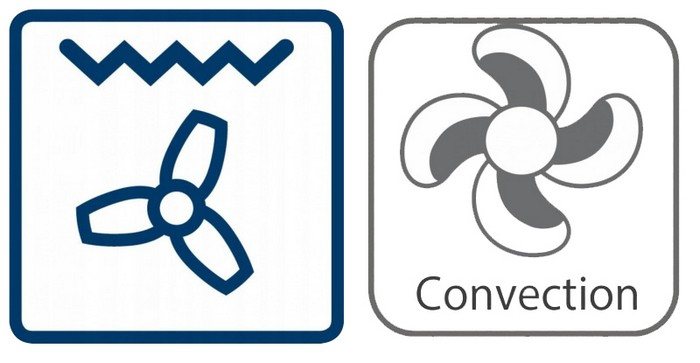
Convection cooking
You cannot use the same oven temperature to cook different dishes. At standard 200 °C, some product may not be baked, while another, on the contrary, will be too dry. Let's look at several options for cooking dishes at different temperatures.
At low temperatures
Temperatures up to 150 °C are considered low for an oven.They are suitable for uniform defrosting of meat or fish - using convection, warm air blows the product from all sides. Herbs and mushrooms, pieces of fruit or nuts are also dried at this temperature. This mode is not suitable for baking or frying, as the heat will not be enough.
At average temperatures
The average oven temperature is from 160 °C to 220 °C. It is sufficient for cooking vegetables, small pieces of meat, fish and baked goods. And in a convection oven, you can easily cook chicken legs in one zone and bake fragrant muffins in another. The main thing is to make sure that no dish stays in the oven for too long, because they have different cooking times.
At high temperatures
Large pieces of meat, poultry or fish are cooked at high temperatures (above 220 °C). Thanks to convection, a crispy crust first appears on the dish, blocking the fat inside, and only then everything else is baked. As a result, everything turns out juicy and tasty.
Subtleties of cooking with convection
Every cook gains experience and his own secrets with practice. However, there are several universal recommendations that everyone should follow when working with a convection oven:
- If the meat is fatty, then you need to start baking it in a cold oven.
- It is better to steam delicate ingredients so that they do not crumble and retain the taste of the nutrients.
- The oven door should be opened as little as possible so that cold air does not “invade” the warm air quietly circulating inside.
- Steamed vegetables need to be cooked in a cooling oven, then they will not turn into porridge. Turn off the oven 15 minutes before the end of the cooking time.
Don't be afraid to experiment. Sometimes masterpieces in the kitchen happen by accident!
User reviews of the mode
I have been cooking in a regular oven all my life, which only heated up. But when I tried an oven with convection and additional features, I was delighted! I bought the same one for my home. Now I can fry, dry, bake evenly, steam, and even grill in the oven!


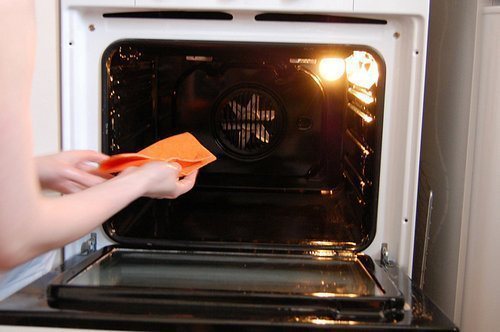

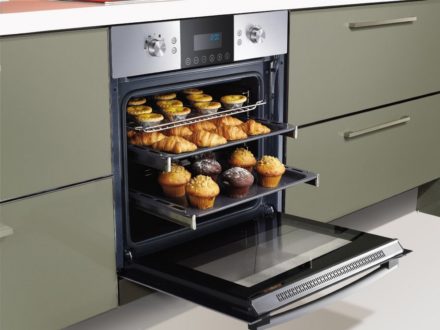
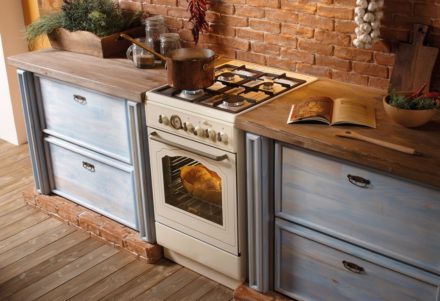
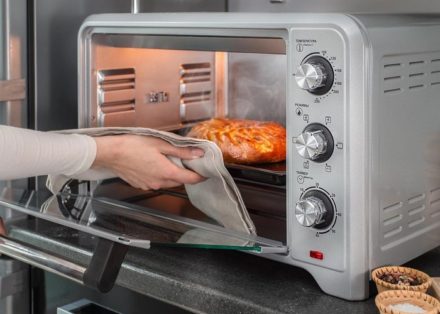

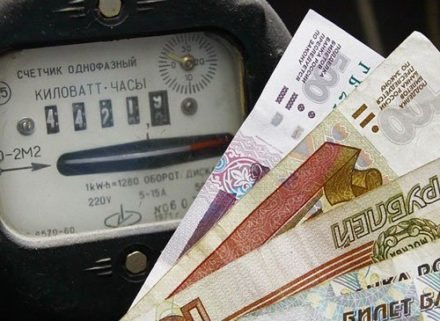
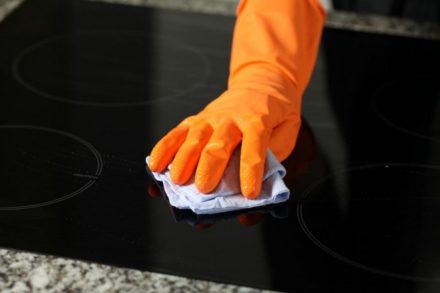
What to do if a rag is burnt to a ceramic stove: simple tips that will help you quickly cope with the problem